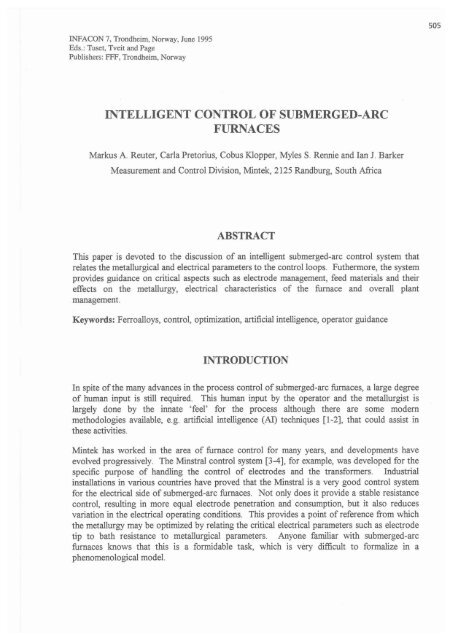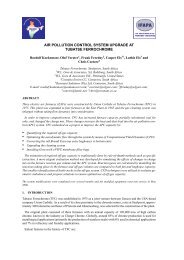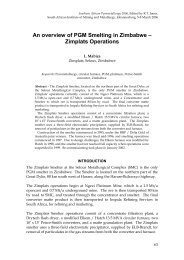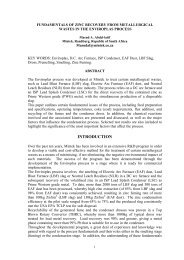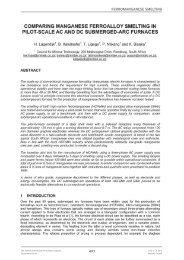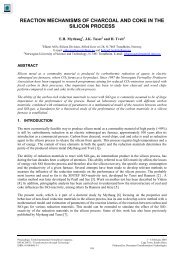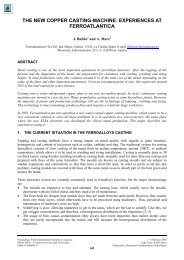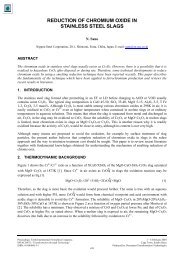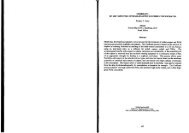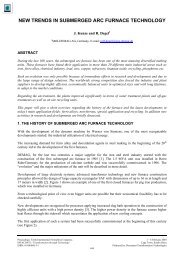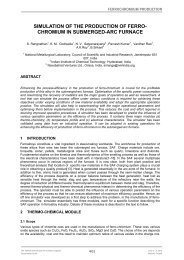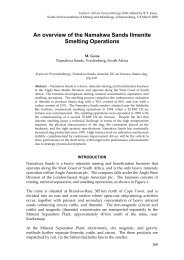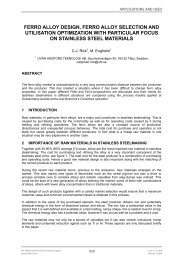intelligent control of submerged-arc furnaces - Pyro.co.za
intelligent control of submerged-arc furnaces - Pyro.co.za
intelligent control of submerged-arc furnaces - Pyro.co.za
- No tags were found...
You also want an ePaper? Increase the reach of your titles
YUMPU automatically turns print PDFs into web optimized ePapers that Google loves.
INFACON 7, Trondheim, Norway, June 1995Eds.: Tuset, Tveit and PagePublishers: FFF, Trondheim, Norway505INTELLIGENT CONTROL OF SUBMERGED-ARCFURNACESMarkus A. Reuter, Carla Pretorius, Cobus Klapper, Myles S. Rennie and Ian 1. BarkerMeasurement and Control Division, Mintek, 2125 Randburg, South AfricaABSTRACTThis paper is devoted to the discussion <strong>of</strong> an <strong>intelligent</strong> <strong>submerged</strong>-<strong>arc</strong> <strong><strong>co</strong>ntrol</strong> system thatrelates the metallurgical and electrical parameters to the <strong><strong>co</strong>ntrol</strong> loops. Futhermore, the systemprovides guidance on critical aspects such as electrode management, feed materials and theireffects on the metallurgy, electrical characteristics <strong>of</strong> the furnace and overall plantmanagement.Keywords: Ferroalloys, <strong><strong>co</strong>ntrol</strong>, optimi<strong>za</strong>tion, artificial intelligence, operator guidanceINTRODUCTIONIn spite <strong>of</strong>the many advances in the process <strong><strong>co</strong>ntrol</strong> <strong>of</strong><strong>submerged</strong>-<strong>arc</strong> <strong>furnaces</strong>, a large degree<strong>of</strong> human input is still required. This human input by the· operator and the metallurgist islargely done by the innate 'feel' for the process although there are some modemmethodologies available, e.g. artificial intelligence (AI) techniques [1-2], that <strong>co</strong>uld assist inthese activities.Mintek has worked in the area <strong>of</strong> furnace <strong><strong>co</strong>ntrol</strong> for many years, and developments haveevolved progressively. The Minstral <strong><strong>co</strong>ntrol</strong> system [3-4], for example, was developed for thespecific purpose <strong>of</strong> handling the <strong><strong>co</strong>ntrol</strong> <strong>of</strong> electrodes and the transformers. Industrialinstallations in various <strong>co</strong>untries have proved that the Minstral is a very good <strong><strong>co</strong>ntrol</strong> systemfor the electrical side <strong>of</strong> <strong>submerged</strong>-<strong>arc</strong> <strong>furnaces</strong>. Not only does it provide a stable resistance<strong><strong>co</strong>ntrol</strong>, resulting in more equal electrode penetration and <strong>co</strong>nsumption, but it also reducesvariation in the electrical operating <strong>co</strong>nditions. This provides a point <strong>of</strong> reference from whichthe metallurgy may be optimized by relating the critical electrical parameters such as electrodetip to bath resistance to metallurgical parameters. Anyone familiar with <strong>submerged</strong>-<strong>arc</strong><strong>furnaces</strong> knows that this is a formidable task, which is very difficult to formalize in aphenomenological model.
506From Mintek's interaction with the ferroalloy industry, major points <strong>of</strong> <strong>co</strong>ncern have beenidentified with regard to furnace operation. These center mostly around electrode managementissues, such as on-line measurement <strong>of</strong> electrode length and the prediction <strong>of</strong> electrode breaks.It also appears that general logging, SCADA and DCS systems are not high priorities bythemselves, probably due to the many such systems that are available. Most <strong>of</strong> these systems,however, do not really address the specific problems related to managing a <strong>submerged</strong>-<strong>arc</strong>furnace operation. With this in mind, Mintek is in the process <strong>of</strong> developing a system(FurnStar) as an expansion to the Minstral <strong><strong>co</strong>ntrol</strong> system, to meet the above-mentionedrequirements.ARCHITECTURE OF THE SYSTEMThe basic philosophy that has been adopted is to use s<strong>of</strong>tware packages that are <strong>co</strong>mmerciallyavailable and to integrate these in the most functional manner, rather than trying to developeverything from basics. This approach <strong>of</strong>fers the following advantages• The generic system <strong>arc</strong>hitecture is independent <strong>of</strong> hardware, SCADA s<strong>of</strong>tware andoperating system.• One can focus on issues that are important to the operation <strong>of</strong> the furnace (e.g.building <strong>of</strong>metallurgical models), rather than on system development.• Users can integrate their own or <strong>co</strong>mmercial s<strong>of</strong>tware packages. This permitsmodules <strong>of</strong>the s<strong>of</strong>tware to be updated with new versions as they are released, withoutthe risk <strong>of</strong>upsetting the performance <strong>of</strong>the whole system.• This open <strong>arc</strong>hitecture ac<strong>co</strong>mmodates many different types <strong>of</strong> <strong>submerged</strong>-<strong>arc</strong> furnacei.e. each system can be customized for each application and can be updated andmaintained by plant personal, ifso required.The basic <strong>arc</strong>hitecture <strong>of</strong> the system <strong>co</strong>nsists <strong>of</strong> a SCADA system <strong>co</strong>mmunicating with theMinstral <strong><strong>co</strong>ntrol</strong> s<strong>of</strong>tware. The SCADA system acts as a front end to various sub-processeswhich, together with the Minstral <strong><strong>co</strong>ntrol</strong> systeJ;ll, <strong>co</strong>mprise <strong>of</strong>the <strong>intelligent</strong> <strong><strong>co</strong>ntrol</strong> as well asvarious sub-programs providing the guidance. A schematic overview <strong>of</strong>the basic <strong>arc</strong>hitectureis given in Figure 1 below.From Figure 1 it is clear that the electrical input provided by Minstral to the FurnStar systeminteracts with various other inputs, ranging from raw materials (preferably from a batchingsystem), furnace <strong>co</strong>nditions, as well as inputs from process models such as expert systems,neural nets, mass and energy balances etc.The operating and metallurgical <strong>co</strong>mplexity <strong>of</strong>most <strong>submerged</strong>-<strong>arc</strong> furnace processes does notlend itself to the use <strong>of</strong> <strong>co</strong>mplex metallurgical models. A more empirical and heuristicapproach (e.g. AI methodologies) was therefore opted for. This has the benefit <strong>of</strong> addressingthe important practical production issues, as will be seen below, and no time is wasted building<strong>co</strong>mplex (and sometimes impractical) process models <strong>co</strong>ntaining numerous, <strong>of</strong>ten dubious,parameters that have to be tuned to represent a certain window <strong>of</strong>operation.
507Intellution FIX ViewFile View Alarms Commands Applications Options HelpFIG. 1. Architecture depicted by a menu screen permitting access to the various subprocesses<strong>of</strong>FurnStarThe direct link to the Minstral <strong><strong>co</strong>ntrol</strong>ler enables datalogging <strong>of</strong> all the important electricalvariables <strong>of</strong> the furnace. These variables are shown on a screen for easy viewing by theoperator (Figures 2 and 3) and stored in the SCADA database. This database is then accessedby the Historical Trending function, which allows the user to trace trends back in time. Thesystem provides features such as:• an expert system <strong>of</strong>fering expert advice on critical metallurgical and electrical issues,and also providing guidance on the selection <strong>of</strong>set-points• neural nets which relate metallurgical and electrical parameters to <strong><strong>co</strong>ntrol</strong> parameters• a model <strong>of</strong> the electric circuit (as also used in the Minstral <strong><strong>co</strong>ntrol</strong> system) todetermine characteristic curves, which provides important information on theelectrical operating point• an electrode management system, giving assistance to the operator on issues such asbaking, as well showing temperature pr<strong>of</strong>iles within the electrodes• automatic load scheduling by downloading predetermined setpoints to the Minstral atthe appropriate times
508• trends <strong>of</strong>important operating parameters by the application <strong>of</strong>neural nets• mass balances by the application <strong>of</strong>, among others, data-re<strong>co</strong>nciliation methods andenergy balances.file ~iew Alarms !;.ommandsIntellution fiX View .!:!elpFIG. 2. Furnace operation screen (i<strong>co</strong>n F3)These features are directly accessible from the SCADA operator interface via the set <strong>of</strong> i<strong>co</strong>nson the different screens, as can be seen in Figures 2 and 3. A number <strong>of</strong>these features will bediscussed in more detail in the following section.SYSTEM FEATURESThis section will be devoted to discussing the various features that are accessed by the variousi<strong>co</strong>ns given in Figure 3.
509Intellution FIX Viewfile ~iew Alarms ~ommands A1!plications .Q.ptions.t!elpCharacteristic CurvesFIG. 3. Data screen in FurnStar summarizing various Minstral dataThe Fll i<strong>co</strong>n is the direct link to the generic application that calculates a furnace'scharacteristic curves online as a function <strong>of</strong>voltage, resistance, power and current [3].Given a specific resistance setpoint, the Minstral will <strong><strong>co</strong>ntrol</strong> the power input to the furnace toa maximum within the <strong>co</strong>nstraints <strong>of</strong> available voltage and MYA as determined by the physicalcharacteristics <strong>of</strong>the transformers and the current <strong>co</strong>nstraint due to the size <strong>of</strong> the electrodes.Figure 4 below shows the characteristic curves for a typical furnace. This enables the operatorto see at a glance all the electrical limits or <strong>co</strong>nstraints to which the Minstral is <strong><strong>co</strong>ntrol</strong>ling andoptimizing power input to the furnace.At the operator's disposal is also the Minstral data screen (Figure 3) summarizing the salientelectrical data <strong>of</strong>the furnace.Set-points and other <strong><strong>co</strong>ntrol</strong>-related aspects are accessed and depicted by the operating screeni<strong>co</strong>nized and driven by function key F4.
510.....;:.: .... "'.. ':":'.:::' :.: .::. '::. : '. :." '.::", ..... ,", ;" ;...:;;..... ;. ":':'":'::. :: ..: '; ;';P/!lIII3020FIG. 4. Characteristic curves screenAll the electrical infonnation on the furnace summarized by the characteristic curves, togetherwith the metallurgical infonnation on the specific process as described in the next paragraph,fonns the basis <strong>of</strong> the expert system that advises the operator and metallurgist on specificsetpoints and other issues for the furnace operation. The system has the ability to download theelectrical setpoints and limits to the Minstral on <strong>co</strong>mmand or automatically.Load SchedulingThe ability to download setpoints to the Minstral via a serial link has made it possible to have aLoad Schedule feature in<strong>co</strong>rporated in the FurnStar system. Since the furnace operationchanges with a difference in load, this <strong>intelligent</strong> <strong><strong>co</strong>ntrol</strong> system detennines a new optimumoperating point in tenns <strong>of</strong> power limits and resistance setpoint, taking the metallurgy andfurnace <strong>co</strong>nditions into <strong>co</strong>nsideration. This infonnation is then downloaded to the Minstral atthe appropriate time ac<strong>co</strong>rding to the load schedule.
511Raw Materials and ProductionThe F2 and F5 i<strong>co</strong>ns takes the user to various Raw Material and Production screens, which areinterfaced to a spreadsheet. With the aid <strong>of</strong> a suitable interface, access is achieved to thefollowing features via the Data Input menu option in Figure 5:• an interface to input raw material and raw materials analyses into a database(Figure 5),• an interface to input production data, metal and slag analyses etc.,• mass and energy balances as a function <strong>of</strong>the above,• features to produce daily production reports and files that interface to the neural net,expert system and other s<strong>of</strong>tware.These data, as well as electrical data from the Minstral, can be <strong>co</strong>mbined and subsequentlymodelled by the application <strong>of</strong>techniques such as neural nets.Figure 6 depicts one such result in which the re<strong>co</strong>very <strong>of</strong> Si in a sili<strong>co</strong>n furnace is <strong>co</strong>rrelated tothe carbon-to-SiOz ratio <strong>of</strong> the feed and electrode tip to bath resistance by the application <strong>of</strong>neural nets [1-2]. From Figure 6, it is clear that an optimum exists for the furnace under<strong>co</strong>nsideration, which in turn can be used to optimally tune the <strong><strong>co</strong>ntrol</strong> system.. .... . . .. .' OreAnaIysls .FIG. 5. Macro-driven interface to a spreadsheet to input raw materials, production andother relevant metallurgical data
512%M-re<strong>co</strong>very1FIG. 6. Neural net relationship <strong>of</strong>sili<strong>co</strong>n re<strong>co</strong>very as a function <strong>of</strong>CIMO <strong>of</strong>the feed andelectrode tip to bath resistanceHistorical Trending and ReportingFunction keys F8 and F9 drive these functions and make use <strong>of</strong> the facilities provided by theapplied SCADA s<strong>of</strong>tware. Numerous different trends may be accessed. Figure 7 depicts one<strong>of</strong>these.Electrode Management using Roses (Realistic Overall Soderberg Electrode Simulator)Guidance on electrode management is another important factor in the operation <strong>of</strong><strong>submerged</strong><strong>arc</strong><strong>furnaces</strong>. As a <strong>co</strong>nsequence, the Roses electrode simulator is being developed with thefollowing features:• electrode baking may be simulated using a finite difference model,• temperature pr<strong>of</strong>iles within the electrode may be determined as a function <strong>of</strong> variouselectrode and electrical parameters, as well as the burden <strong>co</strong>nditions, and• the analysis <strong>of</strong>thermal stresses causing electrode breaks.
513FIG. 7. Historical display <strong>of</strong> hoist position and resistance (one <strong>of</strong> numerous differentscreens)OPERATIONAL BENEFITSFrom the above, it is evident that the system provides the following benefits as a supervisorysystem to the Minstral furnace <strong><strong>co</strong>ntrol</strong>ler.• <strong>furnaces</strong> can be <strong><strong>co</strong>ntrol</strong>led as a function <strong>of</strong> parameters not usually possible withstandard <strong><strong>co</strong>ntrol</strong> theory as applied in the Minstral s<strong>of</strong>tware• electrical and metallurgical parameters are simultaneously in<strong>co</strong>rporated into the<strong><strong>co</strong>ntrol</strong> algorithm, providing a basis for optimizing the furnace as a function <strong>of</strong> boththe electrical and the metallurgical <strong>co</strong>nditions• a basis for managing the electrodes is provided• an electrically and metallurgically balanced furnace operation IS obtained underdifferent load and metallurgical <strong>co</strong>nditions• an <strong>intelligent</strong> basis is provided for operator guidance and training, ultimately leadingto better furnace operation, management and maintenance
514• the effect <strong>of</strong> different feed materials on the <strong><strong>co</strong>ntrol</strong> <strong>of</strong>the furnace and production canbe modelled and in<strong>co</strong>rporated into the <strong><strong>co</strong>ntrol</strong> algorithm.These benefits are not only available to furnace operators, but also to metallurgists andmanagers, especially ifthe network facilities <strong>of</strong>the SCADA s<strong>of</strong>tware are enabled. This wouldpermit the plant manager to view the furnace operation from his <strong>of</strong>fice.Operators would have various tools at their disposal enabling them to infer furnace operationand obtain guidance on electrode management. Likewise, the operators would be able t<strong>of</strong>ormalize their innate feel <strong>of</strong>the process in terms <strong>of</strong>neural net models, expert system rules etc.,and take part in the customizing <strong>of</strong>the system, hence tapping their vast practical knowledge.Guidance is provided by the system on electrical aspects such as (i) suggestions on how, whyand when furnace operating limits set by Minstral can/may be changed, (ii) reasons why andhow to <strong>co</strong>mbat electrodes climbing out etc. Metallurgical guidance includes aspects such as (i)relating feed <strong>co</strong>mpositions to given products and (ii) fault diagnosis i. e. suggesting changes t<strong>of</strong>eed or operation as a function <strong>of</strong> product quality, specific energy input, metal re<strong>co</strong>very/lossesto slag, materials input, type <strong>of</strong>reductant, etc.In summary, metallurgists benefit from knowledge gained by relating electrical andmetallurgical parameters to optimize the energy input to the furnace, as well as to maximizere<strong>co</strong>very. This is the sort <strong>of</strong> tool that is needed to <strong><strong>co</strong>ntrol</strong> the furnace operation by ensuringquality inputs to guarantee quality output.CONCLUSIONFurnStar provides a system by which an optimal furnace operating point can be defined as afunction <strong>of</strong> metallurgical as well as electrical parameters. Where as the Minstral furnace<strong><strong>co</strong>ntrol</strong>ler balances and optimizes the electrical operation <strong>of</strong> a <strong>submerged</strong>-<strong>arc</strong> furnace, the aim<strong>of</strong> the FurnStar system is to provide the user with metallurgical and operational guidance toallow for better overall furnace management, as well optimal <strong><strong>co</strong>ntrol</strong>ler set-points.This system makes it possible to extend the proven e<strong>co</strong>nomic benefits <strong>of</strong> the Minstral [5] byin<strong>co</strong>rporating metallurgical and other non-electrical aspects into the overall <strong><strong>co</strong>ntrol</strong> strategy.ACKNOWLEDGEMENTThis paper is published by permission <strong>of</strong>Mintek.REFERENCES1. Reuter, M.A. Hybrid neural net modelling in metallurgy. Proceedings <strong>of</strong> the 2ndInternational Symposium on Metallurgical Processes for the Year 2000 and Beyond,September 20-23, 1994. H.Y. Sohn (Ed.), San Diego, California. Volume 1, pp. 907-927.
5152. Reuter, M.A, Van der Walt, T.1., and Van Deventer, 1.S.J. Modelling <strong>of</strong> equilibriumprocesses in pyrometallurgy using neural nets. Metal!. Trans. B, vol. 23B, 1992. pp. 643650.3. De Waal, A, Barker, 1.1., Rennie, M.S., Klopper, 1. and Groeneveld, B.S. Electricalfactors Affecting the E<strong>co</strong>nomic Optimi<strong>za</strong>tion <strong>of</strong> Submerged-<strong>arc</strong> Furnaces. INFACON 6.Proceedings <strong>of</strong> the 6th International Ferroalloys Congress, Cape Town. Volume 1,Johannesburg, 1992. pp. 247-252.4. Barker, 1.1., De Waal, A, Rennie, M.S.,and Klopper, 1. The interaction effect in<strong>submerged</strong>-<strong>arc</strong> <strong>furnaces</strong>. Proceedings <strong>of</strong> the 49th Electric Furnace, Toronto, Canada,November 12-15, 1991. Warrendale, the Iron and Steel Society (Electric FurnaceDivision), 1992. pp. 305-310.5. Ngwenya, B.A., Mabi<strong>za</strong>, L., Barker, I.J., De Waal A., Rennie, M.S., and Mailer, P. Theperformance <strong>of</strong> a resistance-based electrode <strong><strong>co</strong>ntrol</strong> system on a <strong>submerged</strong>-<strong>arc</strong> furnace.Paper submitted for presentation at INFACON 7, 1995.
516


